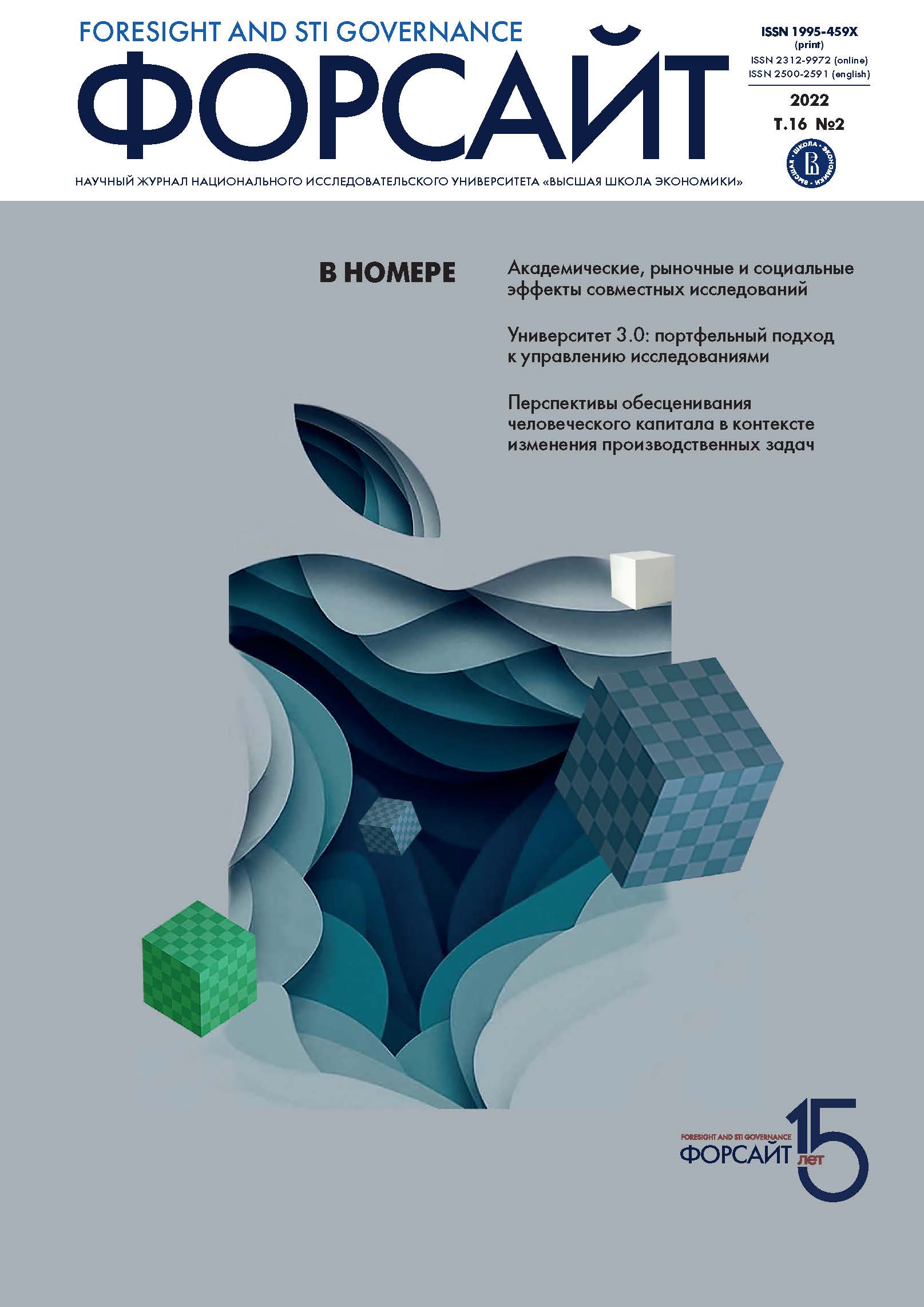Аннотация
В статье на примере биофармацевтического сектора Аргентины проанализированы эффекты совместных исследований, проводимых академическим и промышленным секторами для увеличения результативности научной деятельности, коммерциализации знаний и повышения качества жизни общества. Особое внимание уделено социальным эффектам, которые пока сравнительно редко рассматриваются в литературе. Среди выявленных возможностей, которые сотрудничество с промышленностью открывает для науки — рост публикационной активности, расширение научной повестки за счет прикладных и фундаментальных направлений, появление новых тематических ниш для публикаций, повышение качества преподавания, совместное использование передового оборудования. В промышленных кругах создаваемые знания становятся объектом патентования, источником возникновения стартапов и предложения новых коммерческих услуг. Основные преимущества для социальной сферы заключаются в появлении недорогих местных аналогов диагностических или терапевтических решений.
Литература
Ankrah S., Al-Tabbaa O. (2015) Universities-industry collaboration: A systematic review. Scandinavian Journal of Management, 31, 387-408. DOI: https://doi.org/10.1016/j.scaman.2015.02.003
Arza V., Carattoli M. (2017) Personal ties in university-industry linkages: A case-study from Argentina. The Journal of Technology Transfer, 42, 814-840. DOI: https://doi.org/10.1007/s10961-016-9544-x
Banal-Estañol A., Jofre-Bonet M., Lawson C. (2015) The double-edged sword of industry collaboration: Evidence from engineering academics in the UK. Research Policy, 44, 1160-1175. DOI: https://doi.org/10.1016/j.respol.2015.02.006
Beaudry C., Kananian R. (2013) Follow the (industry) money - The Impact of science networks and industry-to-university contracts on academic patenting in nanotechnology and biotechnology. Industry and Innovation, 20, 241-260. DOI: https://doi.org/10.1080/13662716.2013.791125
Bianchini S., Lissoni F., Pezzoni M., Zirulia L. (2016) The economics of research, consulting, and teaching quality: theory and evidence from a technical university. Economics of Innovation and New Technology, 25, 668-691. DOI: https://doi.org/10.1080/10438599.2015.1114340
Bikard M., Vakili K., Teodoridis F. (2019) When collaboration bridges institutions: The impact of university-industry collaboration on academic productivity. Organization Science, 30, 426-445. DOI: https://doi.org/10.1287/orsc.2018.1235
Bruneel J., D'Este P., Salter A. (2010) Investigating The Factors that Diminish the Barriers to University-Industry Collaboration. Research Policy, 39(7), 858-868. DOI: https://doi.org/10.1016/j.respol.2010.03.006
D'Este P., Llopis O., Rentocchini F., Yegros A. (2019) The relationship between interdisciplinarity and distinct modes of university-industry interaction. Research Policy, 48, 103799. DOI: https://doi.org/10.1016/j.respol.2019.05.008
D'Este P., Patel P. (2007) University-industry linkages in the UK: What are the factors determining the variety of interactions with industry? Research Policy, (36)9, 1295-1313. DOI: https://doi.org/10.1016/j.respol.2007.05.002
Ding W., Choi E. (2011) Divergent paths to commercial science: A comparison of scientists' founding and advising activities. Research Policy, 40, 69-80. DOI: https://doi.org/10.1016/j.respol.2010.09.011
Freeman C. (2004) Technological infrastructure and international competitiveness. Industrial and Corporate Change, 13(3), 541-569. DOI: https://doi.org/10.1093/icc/dth022
Fritsch M., Krabel S. (2012). Ready to leave the ivory tower?: Academic scientists' appeal to work in the private sector. The Journal of Technology Transfer, 37, 271-296. DOI: https://doi.org/10.1007/s10961-010-9174-7
Garcia R., Araújo V., Mascarini S., Santos E., Costa A. (2020) How long-term university industry collaboration shapes the academic productivity of research groups. Innovation: Organization and Management, 22(1), 56-70. DOI: https://doi.org/10.1080/14479338.2019.1632711
Hottenrott H., Lawson C. (2017) Fishing for complementarities: Research grants and research productivity. International Journal of Industrial Organization, 51, 1-38. DOI: https://doi.org/10.1016/j.ijindorg.2016.12.004
Hughes A., Kitson M. (2012) Pathways to impact and the strategic role of universities: New evidence on the breadth and depth of university knowledge exchange in the UK and the factors constraining its development. Cambridge Journal of Economics, 36(3), 723-750. DOI: https://doi.org/10.1093/cje/bes017
Hughes A., Lawson C., Salter A., Kitson M., Bullock A., Hughes R.B. (2016) The Changing State of Knowledge Exchange: UK Academic Interactions with External Organizations 2005-2015, London: NCUB.
Iorio R., Labory S., Rentocchini F. (2017) The importance of pro-social behaviour for the breadth and depth of knowledge transfer activities: An analysis of Italian academic scientists. Research Policy, 46(2), 497-509. DOI: https://doi.org/10.1016/j.respol.2016.12.003
Lee Y.S. (2000) The sustainability of university-industry research collaboration: An empirical assessment. Journal of Technology Transfer, 25(2), 111-133. https://doi.org/10.1023/A:1007895322042.
Libaers D. (2017) Time allocations across collaborations of academic scientists and their impact on efforts to commercialize novel technologies: Is more always better? R&D Management, 47, 180-197. DOI: https://doi.org/10.1111/radm.12164
Lundvall B.A. (1997) National Systems and National Styles of Innovation. Paper presented to the Fourth International ASEAT Conference, Manchester, 2-4 September 1997.
Meyer-Krahmer F., Schmoch U. (1998) Science-based technologies: University-industry interactions in four fields. Research Policy, 27(8), 835-851. DOI: https://doi.org/10.1016/S0048-7333(98)00094-8
Milesi D., Verre V., Petelski N. (2017) Science-industry R&D cooperation effects on firm's appropriation strategy: The case of Argentine biopharma. European Journal of Innovation Management, 20(3), 372-391. DOI: https://doi.org/10.1108/EJIM-07-2015-0058
Nelson R. (ed.) (1993) National Innovation Systems: A Comparative Study, Oxford: Oxford University Press.
Perkmann M., Salandra R., Tartari V., McKelvey M., Hughes A. (2021) Academic engagement: A review of the literature 2011-2019. Research Policy, 50(1), 104-114. DOI: https://doi.org/10.1016/j.respol.2020.104114
Perkmann M., Walsh K. (2009) The two faces of collaboration: Impacts of university-industry relations on public research. Industrial and Corporate Change, 18(6), 1033-1065. DOI: https://doi.org/10.1093/icc/dtp015
Schartinger D., Rammer C., Fischer M.M., Frohlich J. (2002) Knowledge interactions between universities and industry in Austria: Sectoral patterns and determinants. Research Policy, 31(3), 303-328. DOI: https://doi.org/10.1016/S0048-7333(01)00111-1
Stake R. (1995) Investigación con estudios de caso, Madrid: Ediciones Morata (in Spanish).
Van Looy B., Callaert J., Debackere K. (2006) Publication and patent behavior of academic researchers: Conflicting, reinforcing or merely co-existing? Research Policy, 35(4), 596-608. DOI: https://doi.org/10.1016/j.respol.2006.02.003
Verre V., Milesi D., Petelski N. (2021) Science-Industry Cooperation: What Are the Benefits for the Public Part? Evidence from Argentine Biopharmaceutical Sector. International Journal of Innovation and Technology Management, 18(3), 1-22. DOI: https://doi.org/10.1142/S0219877021500073
Yin R.K. (2009) Case study research and applications: Design and methods, Thousand Oaks, CA: Sage Publications.

Это произведение доступно по лицензии Creative Commons «Attribution» («Атрибуция») 4.0 Всемирная.


